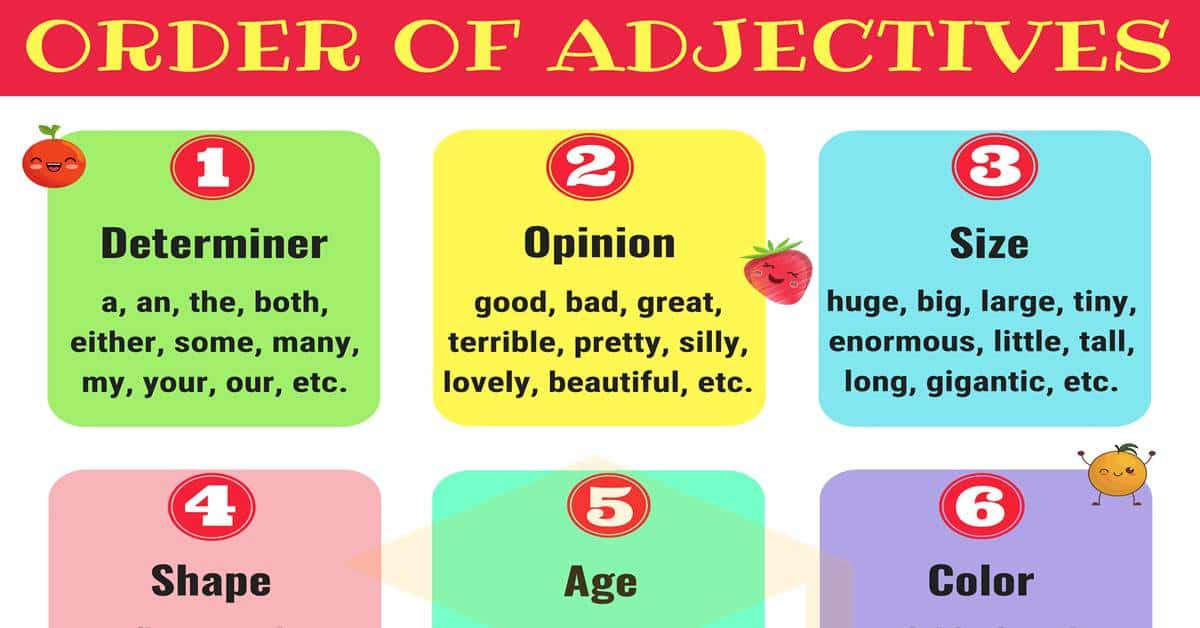What is the correct order of adjectives? When you are going to use a number of different adjectives to describe a noun it is important to be able to put the adjectives in the correct order. The reason for this is that when placed in the wrong order, numerous adjectives can sound misplaced, uneven and somewhat cacophonous.
In this section, we will be looking at the best way to order your adjectives which will not only allow your sentences to flow much more easily but will also give you the impression of being a native English speaker.
Order of Adjectives
In English, it is common to use more than one adjective before a noun. For example, “It is a beautiful long new dress.” or “She has bought a square white Japanese cake.” When you use more than one adjective, you have to put them in the right order – order of adjectives.
Learn how to put adjectives in the right order with useful grammar rules and examples.
In general, the adjective order in English is:
Determiner
Words that work as articles and other limiters including numbers.
Example: a, an, the, both, either, some, many, my, your, our, their, his, her, five, each, every, this, that…
Observation
(Opinion)
In general, an opinion adjective explains what you think about something (other people may not agree with you).
Example: good, bad, great, terrible, pretty, lovely, silly, beautiful, horrible, difficult, comfortable/uncomfortable, ugly, awful, strange, delicious, disgusting, tasty, nasty, important, excellent, wonderful, brilliant, funny, interesting, boring.
Size and Shape
Adjectives that describe a factual or objective quality of the noun.
- A size adjective, of course, tells you how big or small something is.
Example: huge, big, large, tiny, enormous, little, tall, long, gigantic, small, short, minuscule.
- A shape adjective describes the shape of something.
Example: triangular, square, round, flat, rectangular.
Age
An age adjective (adjective denoting age) tells you how young or old something or someone is.
Example: young, old, new, ancient, six-year-old, antique, youthful, mature, modern, old-fashioned, recent…
Color
A color adjective (adjective denoting color), of course, describes the color of something.
Example: red, black, pale, bright, faded, shining, yellow, orange, green, blue, purple, pink, aquamarine…
Origin
Denominal adjectives denoting source of noun.
An origin adjective describes where something comes from.
Example: French, American, Canadian, Mexican, Greek, Swiss, Spanish, Victorian, Martian…
Material
Denominal adjectives denoting what something is made of.
Example: woollen, wooden, silk, metal, paper, gold, silver, copper, cotton, leather, polyester, nylon, stone, diamond, plastic…
Qualifier
(Purpose)
Final limiter, often regarded as part of the noun.
A purpose adjective describes what something is used for. These adjectives often end with “-ing”.
Example: writing (as in “writing paper”), sleeping (as in “sleeping bag”), roasting (as in “roasting tin”), running (as in “running shoes”).
Order of Adjectives | Images

To summarize, in English, adjectives pertaining to size precede adjectives pertaining to age (“little old“, not “old little“), which in turn generally precede adjectives pertaining to color (“old white“, not “white old“). So, we would say “A (determiner) beautiful (opinion) old (age) Indian (origin) lamp.”











0 Comments